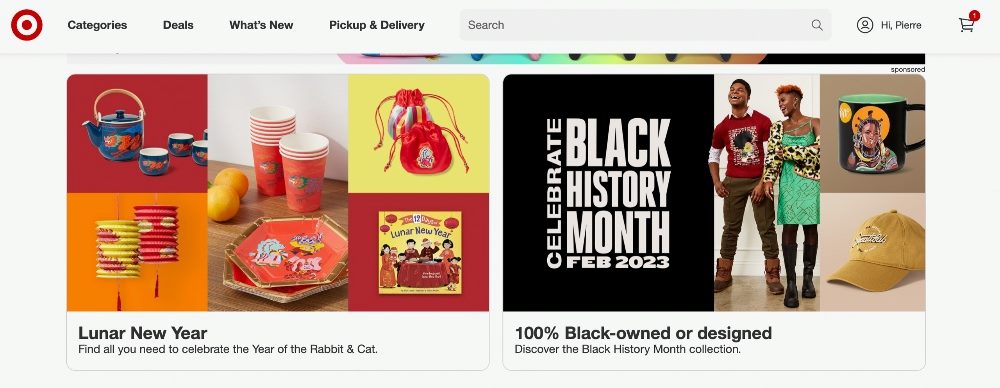The Gist
- Strategy shift. Cultural marketing has evolved into a key marketing strategy to demonstrate how brands fit into customers' lives.
- Model integration. Platform business models are a bridge for blending product offering, messaging and personalization strategy.
- Authentic approach. Combining aspects of platforms and cultural marketing can lead to the right authentic messages and partnerships for special cultural events such as Black History Month.
Of all the personalization marketing that has taken off in the last few years, cultural marketing has been the most revolutionary. Complementing the rising online visibility of discussions during annual cultural holidays and events such as Black History Month, cultural marketing has become a strategic element in bringing marketers closer to diverse customer groups.
But the complexity of reaching diverse groups remains. A notable shift that appears to be bridging this gap is the use of offline and online media within a platform business model. Marketers can leverage this shift to forge stronger connections with customers, from selecting ad creatives to employing AI assistants.
Related Article: Overcoming AI Bias in CX With Latimer
What Is Cultural Marketing?
Cultural marketing, also known as multicultural marketing, is the tailoring of marketing messaging and media to resonate with specific cultural groups. Culture is the customs, arts, social institutions, and landmark achievements of a particular nation, people, or other social group, with traditions, arts, and expressions passed from family to family in various forms.
Growing Personalization
Culture became a highlight in marketing as personalization tactics grew in the messaging to customers. Marketers found that their appeal must speak to customer experiences in a collective way, and culture became highlighted as the shared experiences of a given audience. As marketing served a particular group as an audience, the benefits of infusing culture as an element of the appeal became clear.
A Historical Lens
I explained cultural marketing through the historic lens of African American consumers in a previous CMSWire post. That history emerged as early journalists and marketing pioneers fought for advertising investment. They were working to highlight the economic viability of Black consumers as a market, which was ignored by many brands at the time. One pioneer was Byron Lewis, founder of the Uniworld agency in 1969. Uniworld was the first marketing agency to champion multicultural advertising and promote the interests of Black and Latino consumers.
Data Insights
I also discussed in my post how the African American consumer market has become more visible to marketers through the use of savvy digital media combined with insights from broader economic data trends among the Black middle class. As a result, segments of the African American consumer market have been better researched. For example, Pepper Miller, a prominent marketing researcher who has written extensively on the Black consumer market, examined in her latest book, “Let Me Explain Black Again,” the distinctions and similarities among five of those segments, such as Black immigrants and Black LGBTQ+.
Related Article: Ensuring Cultural Sensitivity in Your Marketing and Advertising
Platforming a Business to Maintain Brand Resonance With Culture
Since my 2019 post, the story has evolved to include an industry trend reaching the largest of retailers to the smallest of businesses. After an era where websites — then mobile apps — were launched, businesses began to treat their digital media as an extension of their operations. This choice transformed business models into a business platform.
An Elevated Position
By most common definitions, a platform implies an elevated position to speak on issues, like a politician discussing campaign topics. However, platforms also refer to an assembly of components, similar to the subassemblies automakers use to build variants of vehicles affordably. For example, the Toyota Supra and the BMW Z4 are two distinct sports cars — BMW manufactures both the Z4, a convertible, and the Supra, a coupe, for Toyota. Subassembly designs enable strategic sharing of vehicle components between the two car designs, reducing development and production costs.
Embracing Platforms
Large retailers have embraced the concept of platforms, positioning their locations and online presence as a "digiphysical" platform. This approach allows for purchasing and customer service activities through a blend of coordinated services via apps, websites and store locations.
Adopting Platforms
Adopting a platform approach to a business model positions businesses to better manage their "elevated position" for sharing branding messages that attract customers. The measure of that attraction is brand resonance. Brand resonance indicates how well people relate to a brand. People become in sync with a brand's message when it demonstrates how their life experiences fit with the brand, well enough to consider becoming lifetime customers of the brand and its products, both existing and new.
Omnichannel Environments
In an omnichannel environment, where customers encounter brand messages through various channels, platforming has become an essential way to oversee marketing elements, including cultural marketing. Cultural marketing is designed to demonstrate how a product, service, or brand fits into the life experiences of customers.

Brand Resonance
Like platforms, brand resonance has been forming in cultural customer experiences for some time. Cheryl Grace, formerly SVP of US strategic community alliances and consumer engagement at Nielsen, highlighted this trend when she spoke at the 2020 CMSWire DX Summit and with Dom Nicastro in his post.
Related Article: Cultural Intelligence Improves the Customer Experience
What Platforms Mean to Cultural Marketing Strategy?
Platforms complement marketer efforts to develop customer experiences through culture-based personalization strategies. They provide opportunities to share messages and imagery that appeal to customers right at the point of sale or when ordering for in-store pickup.
Platform Presence
A platform presence also means marketers must quickly identify when messages and images have been compromised, whether it's a product or campaign. For example, Target removed a game that misidentified historical Black figures from its shelves. This action exemplifies a brand working to protect its brand resonance, striving to be a platform that amplifies the right messages and does not compromise the effort to connect with an audience.
Analytics Capabilities
Platforms also extend analytics capabilities for capturing responses to branding messages, revealing the link between customer behavior and technical responses on a device, whether it's a mobile page or within an app.
Related Article: Cultural Intelligence and CX: Lessons for Better CX From Around the World
What Marketers Can Do
Marketers can gain insights from annual cultural celebrations, learning how to connect with customers from the intended community in the right way.
To do so for Black History Month, for example, marketing teams should keep mind the following concepts:
Go Beyond Performative Actions
Avoid using Black History Month, or any cultural moment, solely as a product or service messaging opportunity, especially if no genuine commitment to diversity and inclusion has been established.
Do Thorough Research
To excel at cultural marketing, marketers must be diligent students, learning the points and counterpoints shared by the culture of a given customer audience. These instances of learning can occur anywhere, whether those points are raised in person at an event or online through a digital community.
Being educated about cultural history, such as Black history, helps to understand which messages perpetuate stereotypes or come across as misappropriation.
Partner to Amplify Black Individuals and Organizations
Brands are learning from successes and misses in cultural marketing, realizing that authentic voices are the best ones to choose for partnerships. These authentic voices, from influencers and businesses, are also applying platform business models to better reflect their value through the customer community they have attracted.
For instance, Health In Her HUE is a healthcare startup connecting women of color with healthcare providers and content tailored to their needs. With nearly 13,000 members and 1,300 health providers across 60 medical specialties, the startup exemplifies the growing success of minority-owned businesses operating as platforms. HUE's recent $3 million seed funding, as reported by TechCrunch, highlights the increasing investment and branding opportunities for authentic partnerships with brands still in their nascent stages.
When collaborating with Black creators, businesses, and experts, marketers should ask how to best amplify voices with a co-created content and campaign plan. The discussions should highlight what genuine platform messaging works for the partners as well as the brand. The result is genuine brand resonance that customers will feel when they see the campaigns.
Know the AI Risks to Cultural Marketing Messaging
Cultural marketing does come with technological risk. The most significant technological risk facing marketers now comes from the arrival of AI image creation. New innovations like OpenAI’s Sora offer convenience for developing imaginative imagery and video. Meanwhile AI models power services associated with platforms, such as labeling documents, segmentations documents, and crafting personalized recommendations.
Brand managers will have to ensure that missteps such as AI hallucinations do not create bad images and break the brand resonance spell for customers.
Marketers can learn from organizations advancing awareness of what artificial intelligence pitfalls can impact AI-features in their platforms work. Such work has become a crucial part of protecting cultural history as AI becomes more widely used. The Algorithmic Justice League, founded by AI researcher Joy Buolamwini, is a nonprofit organization that advocates for AI ethics for impacted communities. Buolamwini is well known for a landmark 2018 study published with independent AI researcher Timnit Gebru that outlines gender and skin-type bias in commercial artificial intelligence systems. New AI models like Latimer look to reduce these biases.
While these ideas have Black History Month in mind, these steps apply when planning the best ways to celebrate cultural events authentically.
Related Article: Is Your Marketing ‘Thoughtfully Inclusive’ of African Americans?
Lessons Through Culture Will Evolve With Revelations
Cultural events and holidays like Black History Month and Chinese New Year will continue to be celebrated, allowing authentic voices to be seen and heard through digital media. Marketers must stay vigilant as the digital nature of platforms brings many long-overlooked historical elements to the forefront, with stories like Byron Lewis' now being documented. Last fall, the Smithsonian's National Museum of American History featured documents and materials from Lewis' career in a display collection.
Understanding culture demonstrates how to connect with an intended audience effectively, respecting their most significant and solemn moments without intrusion. Only through this approach can marketers successfully amplify, represent and empower their audiences.
